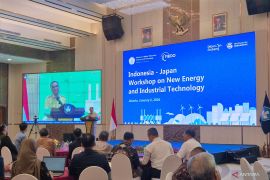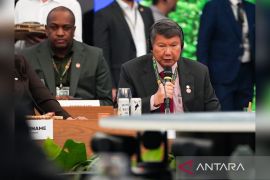Energy and Mineral Resources Minister, Arifin Tasrif, made the remarks in a statement released here on Tuesday.
"We are still importing fuel oil and LPG now. By 2030, the government is targeting to stop fuel oil imports, and, if possible, stop imports of LPG," Tasrif informed.
In 2021, imports of crude oil are projected to reach 118.4 million barrels, valued at US$2,297 billion. Meanwhile, imports of LPG are projected to touch 7.2 million metric tons, valued at an estimated US$411 per metric ton, the minister noted.
The high imports of crude oil and LPG have impacted the current account deficit, which has continued to increase, he said.
The decision to stop imports of fossil fuels demonstrates Indonesia's firmness in implementing the Paris Agreement on reducing greenhouse gas emissions through the use of renewable energy, he added.
"Indonesia needs to anticipate this to encourage the use of renewable energy in the national energy mix," Tasrif said.
Indonesia is targeting to increase the share of renewable energy in its energy mix to 23 percent by 2025 from the 11.2 percent currently, he disclosed.
According to data provided by the Energy and Mineral Resources Ministry, the capacity of renewable energy-generating power plants in Indonesia has reached 10,467 MW — with hybrid power plants contributing 3.6 MW, wind-generated plants 154.3 MW, solar plants 153.8 MW, bio energy 1,903.5 MW, geothermal energy 2,130.7 MW, and hydro power plants 6,121 MW.
The government is targeting to have 24 thousand MW of installed capacity of environment-friendly electricity by 2025, and increase it to 38 thousand MW by 2035, Tasrif said.
"We are attempting to use solar as the backbone of our national energy source," he added.
The government has prepared strategies to develop solar energy, which include the development of large-scale solar energy plants (PLTS) on former mining sites and unproductive land; floating photovoltaic solar power plants; rooftop solar power plants; and, conversion of steam-generated power plants (PLTU) to PLTS, the minister informed.
In addition, the government has initiated plans to use Sumba Island in East Nusa Tenggara as a solar energy source given its potential to produce 1,800 MW of electricity per year, 25 percent above the national average, he said.
The intensity of solar radiation in Sumba Island is 4.8 kWh per day, and there is abundant land in the province, thus, establishing a PLTS with a capacity of 50 thousand MW is possible, he added.
The PLTS could supply electricity from Sumba Island to Java, he said.
In 2020, the installed capacity of PLTS in Indonesia stood at 153.8 MW, or 0.07 percent of the total realization of mixed energy of 10,500 MW, or 11.2 percent of the national energy mix. (INE)
Related news: Indonesia, Germany agree to support clean energy transition
Related news: ESDM Ministry to build solar park across eastern Indonesia
EDITED BY INE
Translator: Sugiharto Purnama, Sri Haryati
Editor: Suharto
Copyright © ANTARA 2021












